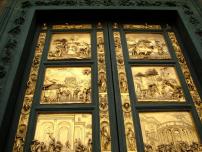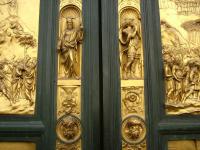THE BAPTISTERY OF ST JOHN
THE BAPTISTERY OF ST JOHN (Battistero San Giovanni) is the oldest and most venerated building in Florence, famous for its bronze doors and the gold ground mosaics on its ceiling and should not be missed.

Detail of The Baptistery circa 1835 from an oil by Giuseppe Gheradi from a private collection. Photographed at the 1994 Belvedere Gallery Exhibtion.
HISTORY OF THE BUILDING. This octagonal edifice was once a Roman temple dedicated to Mars, the god of war, built when the Romans occupied the area known as Florentia. What is now the Baptistery was built in the 6th century AD. on the foundations of that crumbling Roman temple.
Once the Romans left the Tuscans called their settlement Firenze. When the city became popular with English visitors making the Grand Tour they anglicized the name to Florence, a name they found easier to pronounce.

The famous mosaic ceiling has a magnificent Byzantine-inspired Christ in Majesty.
By the 13th century the octagonal stone building had received a decorative cladding of dark green and white marble and was dedicated to the patron saint of Florence — John the Baptist (San Giovanni). The building was the site of mass baptisms on 24 June each year which is the feast day of San Giovanni.
THE SOUTH DOORS. In 1336 Andrea Pisano was commissioned to design doors with 28 panels illustrating the life of John the Baptist. The bronze doors were paid for by a levy on the guild of wool merchants, production and export of wool being Florence's most profitable industry in the fourteenth century, the start of the Renaissance. Pisano's designs were regarded by prelates and priests as valuable teaching tools as so many Florentine working people could not read or write.
THE NORTH DOORS. In 1841 a former goldsmith named Lorenzo Ghiberti won a competition to design a second set of doors for the Baptistery. The rules insisted all competitors had to submit a sample panel illustrating the sacrifice of Abraham of his beloved son, Isaac, required of him by Jehovah, as a test of faith.
Ghiberti won the contest with a striking design. It depicted an agonised Abraham with a knife over the throat of his young son who he is about to kill to demonstrate his obedience to the God of the Israelites. The fine detail and of the carved figures in the sample panel won Ghiberti the right to design another set of doors and he triumphed over his closest rival Filippo Brunelleschi, who then abandoned sculpture for architecture and would go on to design the dome of the Cathedral. Today Ghiberti's competition entry in the Bargello Sculpture Museum.
Ghiberti spent the 20 years designing and supervising the casting of 28 large bronze panels for the North Doors. He was aided by talented young apprentices some eventually famous in their own right like the painters Masolini and Paolo Ucello and the future sculptor Donato di Niccolo Bardi (known as Donatello).
The citizens of Florence claimed Ghiberti's North Doors made characters from the pages of the New Testament seem like real people, which was very important since so many of them were illiterate.
THE EAST DOORS (known as The Gates of Paradise). In 1425 Ghiberti was commissioned to create a second set of doors based scenes from the Old Testament. Aided by apprentices Ghiberti worked on the design and execution of what is now seen as his masterpiece between 1425- 1452.
Ghiberti himself described how,
“I strove to imitate nature as closely as I could and with all the perspective I could produce. …In some scenes I placed as many as 100 figures, in some less. I executed the work with the greatest diligence and the greatest love. There were ten stories in all [sunk] in frames because the eye form a distances measures and interprets the scenes in such a way that they appear round. … Executed with study and perseverance, of all my work this is the most remarkable.â€
Dramatic scenes Ghiberti selected from his readings of the Old Testament included:
The creation of Eve from Adam's rib
The expulsion of Adam and Eve from the Garden of Eden
Cain and Abel
Noah and his Ark
Moses receiving the tablets of the law
The collapse of the walls of Jericho
King Solomon meeting the Queen of Sheba.

In the door frame Ghiberti included a small sculpture of his head.
The figures on each bronze panel are in bas or ‘ low' relief'. The most important figures were cast separately and joined to their panels by concealed screws. In the door frame Ghiberti included a small sculpture of his head, inset into the decorative frame of leaves and flowers.
The elegance of Ghiberti's design and the brilliance of its execution, won the admiration of Michelangelo who claimed these doors were ‘fit to grace the gates of Paradise' — the name by which they are known today.
For conservation reasons Ghiberti's bronze doors have been replaced by replicas and the originals are in the Museum of the Opera del' Duomo.


